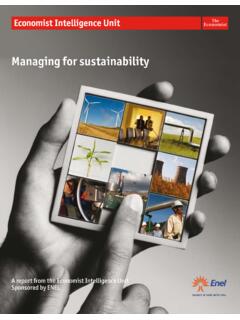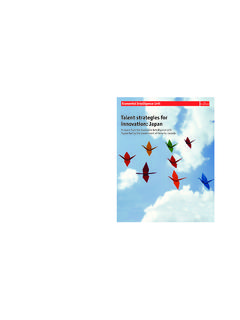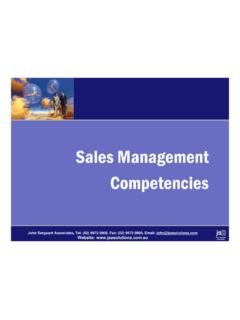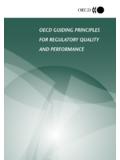Transcription of Strategy execution: Achieving operational …
1 Economist Intelligence Unit 2004 1 Strategy execution : Achieving operational excellence The benefits of management transparency An Economist Intelligence Unit survey Sponsored by Celerant Consulting Strategy execution : Achieving operational efficiency summarises the findings of an Economist Intelligence Unit survey of senior 276 executives in the US and Canada, sponsored by Celerant Consulting. The Economist Intelligence Unit bears sole responsibility for the content of the report. Fifty percent of the survey s respondents are within the C-suite, and all have operational responsibilities. Participants are drawn from eight industries: manufacturing (17%), oil & gas (16%), life sciences (12%), chemicals (11%), telecoms (11%), healthcare (11%), consumer goods (11%) and retail (11%).
2 Fifty percent represent companies with over US$500m in annual revenue. Full respondent demographics are contained in the appendix. The survey was conducted via electronic and telephone activity in September and October 2004. Our sincere thanks go to all the executives who took part in this research. November 2004 Economist Intelligence Unit 2004 2 Executive summary All companies value operational efficiency. But few organisations excel at designing, communicating and managing their performance-improvement initiatives, according to a new survey conducted by the Economist Intelligence Unit and sponsored by Celerant Consulting. The survey of 276 senior operations executives in the US and Canada targeted eight key industries: manufacturing, oil & gas, life sciences, chemicals, telecoms, healthcare, consumer goods and retail.
3 It shows that top performers (defined as those outperforming their industry in revenue growth and reporting themselves to be successful or very successful at executing strategic initiatives over the past three years) have more committed management , make better and more frequent use of performance data and management mechanisms, and have stronger communication channels to link senior management with frontline employees in a transparent manner. But even among top performers, there are significant barriers to Achieving operational excellence . Key findings: Growth intimately tied to efficiency. Most companies expect steady or accelerating revenue growth. But to compete in a globalised economy, with labour shortages and rising input costs, companies must achieve ever greater levels of operational efficiency.
4 This imperative underpins respondents primary strategic goals of improving customer satisfaction and increasing shareholder value. Communication essential to meeting strategic goals. Only 43% rate their companies as having been successful or very successful at executing strategic initiatives over the past three years. They cite communication between senior management and frontline employees as the biggest challenge in ensuring successful execution and the most important to get right. What can t be measured can t be optimised. Companies that are disappointed with Strategy execution also tend to struggle with data collection and measurement. They do not regularly employ or even have access to timely, accurate management data to guide the success of strategic initiatives.
5 Efficiency issues forcing companies to look inward. Over the past three years, outsourcing of IT and business processes has ranked among the most common performance-improvement initiatives. The focus in the coming year, however, will be more inward-looking: corporate organisation realignment, business process re-engineering and major technology implementation will be the most common initiatives. Top performers distinguished by greater transparency. Top-performing companies are defined as those outperforming their industry in revenue growth and reporting themselves to be successful or very successful at executing strategic initiatives over the past three years. These companies, which comprise 28% of the overall respondent base, make better use of performance data and measurement mechanisms and have stronger communication channels between senior management and frontline employees.
6 Economist Intelligence Unit 2004 3 Survey results Most companies have seen an uptick in revenue growth over the past year (Figure 1). Sixty-seven percent of participants say their companies experienced revenue growth in the most recent fiscal year. Eighty-three percent expect their companies growth rate to remain steady or even accelerate over the coming year (Figure2). Figure 1. Which best describes your company s revenue growth or decline in the most recent fiscal year? Figure 2. Do you expect your company s revenue growth to accelerate, decelerate, or remain steady in 2005, compared to this year? But steadily improving financial performance is far from assured.
7 Executives see threats in the form of competition from lower-cost labour markets, regulatory change, increasing raw materials prices, and a lack of qualified labour (Figure 3). To meet these challenges, companies recognise that they must hone operations and strive for ever greater efficiency. 4%6%9%6%8%14%20%17%16%20% or more decrease over prior year10-20% decrease5-10% decrease1-5% decreaseNo change1-5% increase5-10% increase10-20% increase20% or more increase over prior year55%12%28%5%AccelerateDec eler at eRemain steadyNot s ur e Economist Intelligence Unit 2004 4 Figure 3. Looking forward, which of the following issues represents the greatest potential threat to the successful operations of your company?
8 Select all that apply. 14%2%11%11%18%23%28%31%32%34%OtherFailur e to comply w ith the Sarbanes-Oxley ActRising interest ratesLack of innovative capital equipmentRising energy pricesMacroeconomic or political upheavalLack of qualif ied labourIncreasing raw materials pricesRegulatory changeCompetition f rom low er-cost labour markets Over the past three years, outsourcing of IT and business processes has ranked among the most common performance-improvement initiatives undertaken by respondents. But the survey suggests that the focus will shift inward to issues of corporate organisation and internal efficiency over the next three years (Figure 4). Companies indicate their single biggest performance-improvement initiative will be corporate organisation realignment, business process re-engineering or a major technology implementation.
9 Among the 78 high-performance companies participating in the survey comprising 28% of all respondents the emphasis will be less upon corporate re-organisation and more upon major technology implementation. Figure 4. Which initiative is your company or business unit most likely to focus on over the next year? 5%3%4%6%6%8%9%9%10%11%14%15%OtherIT outsourcingDivest non-core assetsDirect or indirect procurement initiativesBusiness process outsourcing (including manuf acturing operations)Supply-chain rationalisationProcess automationLean Manuf acturingSix SigmaMajor technology implementation (ERP, CRM, etc)Business process re-engineeringCorporate organisation realignment The survey shows that operational efficiency underpins companies most basic strategic goals (Figure 5).
10 Improving customer satisfaction (picked by 61% of respondents as being Economist Intelligence Unit 2004 5among their companies top three strategic objectives) and increasing shareholder value (49%) both depend heavily on Achieving operational efficiency. Forty-six percent of executives identified improving operational efficiency itself as one of their companies top objectives. Figure 5. What are the most important strategic objectives to your company or business unit? Please select up to three objectives. 6%14%31%33%43%46%49%61%OtherImprove employee retention/moraleIncrease market shareReduce/contain costsGrow top-line revenuesImprove operating ef f iciencyIncrease shareholder valueImprove customer satisf action, loyalty, retention Few respondents are wholly satisfied with their track record in delivering on their strategic objectives.














